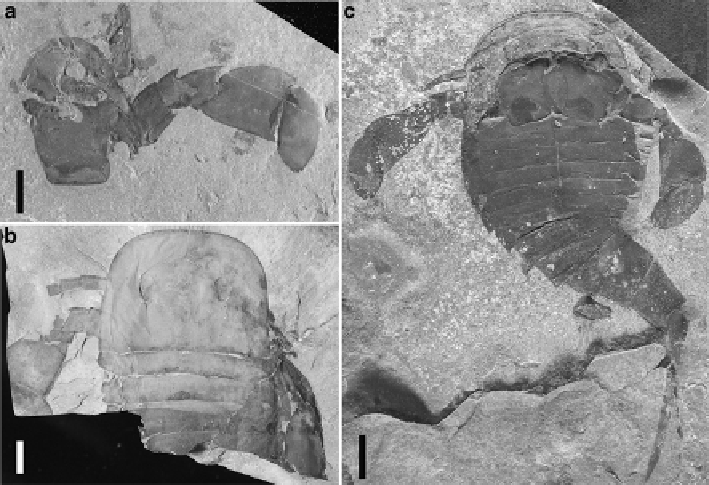Geology Reference
In-Depth Information
Fig. 7.1
Some of the specimens with preserved cuticle that were analysed (for correlation, see
Table
7.1
). Scale bars 10 mm. (
a
)
Eurypteruslacustris
from Ridgemount Quarry, Canada (YPM
209615). (
b
)
E. lacustris
from Fort Erie railroad cut, Canada (YPM 209620). (
c
)
E. dekayi
from
Ridgemount Quarry, Canada (YPM 209619)
base of the Joggins Formation (Stankiewicz et al.
1998a
). The slightly younger
horizon at Lone Star Lake, Kansas, which yields scorpion material used for
comparison, is Kasimovian or Gzelian age (ca 303 MA). The samples came from
bed 13 of Archer and West (
1991
), a grey shale. The new cuticle samples analyzed
are held in the Yale Peabody Museum (YPM) under the repository numbers given
in Table
7.1
.
The eurypterid cuticles analysed represent fi ve different taxa belonging to three
different clades, or superfamilies, of eurypterids. They were almost exclusively
carbonaceous and no mineralization (e.g., phosphatisation) was observed. The
superfamily Eurypteroidea is represented by
Eurypteruslacustris
(Fig.
7.1a-b
) and
E. dekayi
(Fig.
7.1c
), both from the Williamsville Formation. The superfamily
Adelophthalmoidea is represented by
Adelophthalmus
sp. from the Joggins
Formation, while the Pterygotoidea is represented by
Pterygotusventricosus
from
the Wabash Formation and
P. sarlei
from the Vernon Formation. The cuticle of two
modern chelicerates, the emperor scorpion
Pandinus imperator
and the North
American horseshoe crab
Limulus polyphemus
, were used for comparative analysis.
Horseshoe crabs are widely accepted as a sister group to (eurypterids + arachnids);
the position of scorpions is more equivocal, but they are usually considered close to
eurypterids (e.g., Dunlop and Braddy
2001
).

Search WWH ::

Custom Search